-
Notifications
You must be signed in to change notification settings - Fork 8
Working Group Example 2
This page gives an example of one possible way of using working group organizations to keep track of issues, branches, and pull requests within a working group. This model is the one used by the Tools Working Group (TWG).
[Another example](Working Group Example 1) shows how the Fault Tolerance Working Group operates.
In this guide, we assume that your repository is set up in the same way as the Initial Git setup guide.
As with the main mpi-forum organization, the working groups have two main repositories.
-
The first,
mpi-standard, is a fork of thempi-forum/mpi-standardrepository and is kept private. The source code for the MPI Standard is in this repository and it can be used as a sandbox for the working groups to draft proposals before submitting them as pull requests to the MPI Forum. -
The second repository,
<wg>-issues, is named differently for each working group, but is the public space where the working group can house its wiki pages and issues to let anyone view and make comments. This repository does not have any actual code as it is kept in thempi-standardrepository.
More details for how the working groups are set up can be found in the Working Group Guidelines guide.
The main difference in how working groups operate comes from branch management. In the TWG, there are three types of branches that are stored in the mpi-standard repository:
-
Branches derived from the main
mpi-forum/mpi-standardrepository. These branches includempi-3.x,mpi-2.x, etc. These branches are kept in sync with the their counterpart branches in the upstreammpi-forum/mpi-standardrepository. -
Git feature branches. These are branches created by Working Group members for text changes that they want the Working Group to review (before going up to the full MPI Forum). These branches are used for pull requests to the
integrationbranch. -
The
integrationbranch. This branch is the pull request target for Tools Working Group feature branches. The purpose of this branch is so that the TWG can build a full copy of the MPI standard document with all their proposed changes that have not yet been accepted in to the upstreammpi-forum/mpi-standardrepository yet.
The Tools repository looks like the repo on the right hand side of this image:

The general workflow for a TWG member to propose new text is threefold:
- File an issue + pull request in the
mpiwg-toolsorganization. - Discuss the proposal in the Working Group. Merge the pull request when consensus is reached.
- File a corresponding issue + pull request in the
mpi-forumorganization.
- TWG member creates a public issue in
mpiwg-tools/tools-issues. - TWG member creates a feature branch in
mpiwg-tools/mpi-standardand pushes commits with the proposed text changes. - TWG creates a private pull request in
mpiwg-tools/mpi-standard.- The target is the
integrationbranch on thempiwg-tools/mpi-standardrepository. - The source is the feature branch that the TWG member just pushed to the same
mpiwg-tools/mpi-standardrepository (yes, you can have a pull request source and target in the same repository).
- The target is the
- TWG discusses the pull request. The pull request may get modified during the course of the TWG discussions.
- Once consensus is reached and the pull request is ready, it is merged to the
integrationbranch.
Essentially repeat the above procedure, but:
- File the public issue in the
mpi-forum/mpi-issuesrepository. - File the private pull request in the
mpi-forum/mpi-standardrepository.- The target is the relevant branch (e.g.,
mpi-3.x) on thempi-forum-tools/mpi-standardrepository. - The source is the feature branch that the TWG member just pushed to the same
mpiwg-tools/mpi-standardrepository.
- The target is the relevant branch (e.g.,
Yes, the source branch is the same feature branch in the mpiwg-tools/mpi-standard in for both the internal TWG pull request and the full MPI Forum pull request. This actually guarantees that the text discussed in the TWG is exactly the same as what is presented to the full MPI Forum.